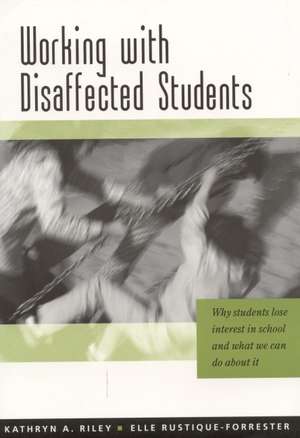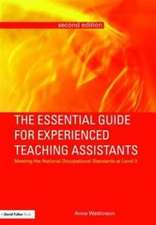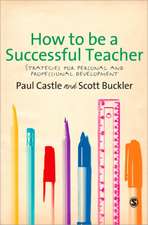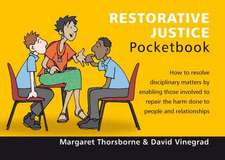Working with Disaffected Students: Why Students Lose Interest in School and What We Can Do About It
Autor Kathryn Riley, Elle Rustique-Forresteren Limba Engleză Paperback – 15 aug 2002
`Working with Disaffected Students is an interesting, informative and accessible book which should appeal to the target audience of practitioners and policy makers. The recommendations in this book are sound and highly relevant to the target audience. Everyone, particularly the disaffected young people themselves, should benefit from sound research presented in such and engaging and accessible way' - British Journal Educational Studies
`The book stresses the importance of early (and real) inter-agency co-operation, and of good initial and on-going teacher training' - Michael Duffy, The Times Educational Supplement
`I cannot tell you how much I enjoyed the grown up approach of this book, soundly grounded in evidence, and not afraid to talk in terms of a really inclusive approach. In particular, I loved to hear the clear statements on the need for trust between Government and Schools' - Education Review
`This is a humane and reflective book. One for all teachers, heads and other professionals involved in children's welfare. It should be compulsory reading for the target-setters accountability merchants, as it demands a very different king of responsibility towards vulnerable children and their future' - Improving Schools
`An insightful, powerful and, at times, worrying exploration of reasons for children choosing, or being forced, not to attend school. I feel that this book is a must-read for teachers, parents and carers alike. If the powerful messages are absorbed and internalized, then perhaps new ways of exploring the relationships required with children who become disaffected can be found' - Lynne Westwood, Working with People Who Have a Learning Disability
'This book is a welcome and timely addition to the growing body of research and writing on educational inclusion…. It is a rich source of good practice, policies and ideas. Used skillfully, it could be a powerful resource to influence a school's approach to the management of student disaffection…. I would recommend this book as essential source of empowerment for all who aspire to improve schools and include all' - Alan J Child, Journal of InService Education
`This book provides policy-makers and practitioners with positive strategies for best practice, helping them to formulate and implement policies that will improve prospects for disaffected pupils. The authors encourage inclusive solutions that emphasise working in partnership' - SENCO Update
This accessible book is about pupil disaffection. It tackles some of the issues which confront policy makers and practitioners in many countries and contexts. Education has become a political priority for many governments, and many have sought to tackle the issues of underachievement and failure. But if education is a political priority, why aren't school days `the best days of your life'? Why are so many students - and their teachers - unhappy with their lot?
Most children start school at five, or thereabouts, with enthusiasm and curiosity. Most parents want the best for their children. Most teachers enter the teaching profession because they are motivated by enthusiasm for their subject, or by a commitment to support children's learning. Most teachers who become head teachers do so because they want to make a difference to young people's lives. For many teachers and their pupils, education is a rewarding experience.
But what happens over the years to lead to disaffection in a sizeable minority? Why does the partnership between schools and families succeed for some, but fall apart for others? Why do some young people reject school and become excluded from learning? What forces the different 'camps' to blame each other ?
International studies have shown that education attainment at age 16 is the most important predictor of future participation in learning, and of labour market opportunities. Young people with no qualifications are between two and three times more likely to be unemployed as their peers, and to be excluded from society. They become disenfranchised by their lack of educational opportunities.
This book is more than another tale of pupil disengagement. From talking to parents, pupils and teachers, the authors provide some answers to the questions:
- What can be done to realize the high expectations that are shared by parents, pupils and teachers alike when children first start their schooling?
- What can be done to make a difference?
Preț: 419.39 lei
Preț vechi: 493.41 lei
-15% Nou
Puncte Express: 629
Preț estimativ în valută:
80.25€ • 83.25$ • 66.92£
80.25€ • 83.25$ • 66.92£
Carte tipărită la comandă
Livrare economică 27 martie-10 aprilie
Preluare comenzi: 021 569.72.76
Specificații
ISBN-13: 9780761940784
ISBN-10: 0761940782
Pagini: 114
Ilustrații: black & white illustrations
Dimensiuni: 170 x 242 x 8 mm
Greutate: 0.24 kg
Ediția:First Edition
Editura: SAGE Publications
Colecția Sage Publications Ltd
Locul publicării:London, United Kingdom
ISBN-10: 0761940782
Pagini: 114
Ilustrații: black & white illustrations
Dimensiuni: 170 x 242 x 8 mm
Greutate: 0.24 kg
Ediția:First Edition
Editura: SAGE Publications
Colecția Sage Publications Ltd
Locul publicării:London, United Kingdom
Recenzii
`Working with Disaffected Students is an interesting, informative and accessible book which should appeal to the target audience of practitioners and policy makers. The recommendations in this book are sound and highly relevant to the target audience. Everyone, particularly the disaffected young people themselves, should benefit from sound research presented in such and engaging and accessible way' - British Journal Educational Studies
`The book stresses the importance of early (and real) inter-agency co-operation, and of good initial and on-going teacher training' - Michael Duffy, The Times Educational Supplement
`An insightful, powerful and, at times, worrying exploration of reasons for children choosing, or being forced, not to attend school. I feel that this book is a must-read for teachers, parents and carers alike. If the powerful messages are absorbed and internalized, then perhaps new ways of exploring the relationships required with children who become disaffected can be found' - Lynne Westwood, Working with People Who Have a Learning Disability
'This book is a welcome and timely addition to the growing body of research and writing on educational inclusion…. It is a rich source of good practice, policies and ideas. Used skilfully, it could be a powerful resource to influence a school's approach to the management of student disaffection…. I would recommend this book as essential source of empowerment for all who aspire to improve schools and include all' - Alan J Child, Journal of InService Education
`This book provides policy-makers and practitioners with positive strategies for best practice, helping them to formulate and implement policies that will improve prospects for disaffected pupils. The authors encourage inclusive solutions that emphasise working in partnership' - SENCO Update
`This is a humane and reflective book. One for all teachers, heads and other professionals involved in children's welfare. It should be compulsory reading for the target-setters accountability merchants, as it demands a very different king of responsibility towards vulnerable children and their future' - Improving Schools
`I cannot tell you how much I enjoyed the grown up approach of this book, soundly grounded in evidence, and not afraid to talk in terms of a really inclusive approach. In particular, I loved to hear the clear statements on the need for trust between Government and Schools' - Education Review
`The book stresses the importance of early (and real) inter-agency co-operation, and of good initial and on-going teacher training' - Michael Duffy, The Times Educational Supplement
`An insightful, powerful and, at times, worrying exploration of reasons for children choosing, or being forced, not to attend school. I feel that this book is a must-read for teachers, parents and carers alike. If the powerful messages are absorbed and internalized, then perhaps new ways of exploring the relationships required with children who become disaffected can be found' - Lynne Westwood, Working with People Who Have a Learning Disability
'This book is a welcome and timely addition to the growing body of research and writing on educational inclusion…. It is a rich source of good practice, policies and ideas. Used skilfully, it could be a powerful resource to influence a school's approach to the management of student disaffection…. I would recommend this book as essential source of empowerment for all who aspire to improve schools and include all' - Alan J Child, Journal of InService Education
`This book provides policy-makers and practitioners with positive strategies for best practice, helping them to formulate and implement policies that will improve prospects for disaffected pupils. The authors encourage inclusive solutions that emphasise working in partnership' - SENCO Update
`This is a humane and reflective book. One for all teachers, heads and other professionals involved in children's welfare. It should be compulsory reading for the target-setters accountability merchants, as it demands a very different king of responsibility towards vulnerable children and their future' - Improving Schools
`I cannot tell you how much I enjoyed the grown up approach of this book, soundly grounded in evidence, and not afraid to talk in terms of a really inclusive approach. In particular, I loved to hear the clear statements on the need for trust between Government and Schools' - Education Review
Cuprins
Foreword - Chris Trinick
PART ONE: INTRODUCTION
School Lives
Fact and Fiction
PART TWO: SETTING THE SCENCE
A Problem Shared?
Putting the Study in Place
PART THREE: TELLING TALES OUT OF SCHOOL
Children's Voices
Parent's Voices
Teachers and Head Teachers in the Firing Line
PART FOUR: POLICY AND PRACTICE IN SOCIAL INCLUSION
Different Voices but Similar Tales
Policy into Practice
Making Changes Happen
No More Villains
PART ONE: INTRODUCTION
School Lives
Fact and Fiction
PART TWO: SETTING THE SCENCE
A Problem Shared?
Putting the Study in Place
PART THREE: TELLING TALES OUT OF SCHOOL
Children's Voices
Parent's Voices
Teachers and Head Teachers in the Firing Line
PART FOUR: POLICY AND PRACTICE IN SOCIAL INCLUSION
Different Voices but Similar Tales
Policy into Practice
Making Changes Happen
No More Villains
Descriere
`The book stresses the importance of early (and real) inter-agency co-operation, and of good initial and on-going teacher training' - Michael Duffy, The Times Educational Supplement









